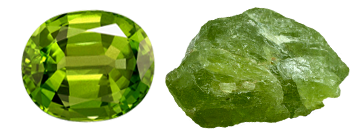 Photo of Peridot in Processed & Rough Form
Photo of Peridot in Processed & Rough Form
Peridot is a mineral with a hardness of 7 out of 10 on the Mohs scale of mineral hardness [?]. These Orthorhombicly structured gems are made of magnesium iron silicate, their full chemical compound being (Mg,Fe)2SiO4.
Peridot is the greener type of gem-quality specimen of Forsterite-Olivine, which is an important, rock-forming mineral, a silicate of magnesium and iron. Often their names are used interchangeably. The bottle-green/olive green type of olivine is also called olivine. The yellower type of olivine is called Chrysolite.
It forms as thick, tabular crystals, frequently with wedge-shaped terminations. The color ranges from pale yellow-green to pale olive green to dark green.
It has vitreous luster, and is usually transparent. It tends to burst under great stress, therefore is sometimes metal-foiled. Dark stones can be lightened by burning. Rarities are peridot cat's eye and star peridot.
The particular color and luster of peridotare highly characteristic, although some tourmalines, zircons, and chrysoberyls may look much the same. A quick way of distinguishing them is by testing the density.
Peridot in olivine is very widely-distributed in iron- and magnesium-rich igneous rocks. The most important deposits are in the Red Sea on the volcanic island of St. John (Egypt), where they have been mined for 3,500 years. Beautiful crystals can be found on the walls of cavities of weathering peridot rock. Good material can also be obtained from serpentine. There are also quarries in upper Burma, where bright-green well-formed crystals are found. Hawaiian peridot is found on beaches. Stones from Ameklovdalen, Sondmore, Norway, are iron-poor and a bright yellowish green. Gem-quality peridot is found in China in the Zhangjikou-Xuanhua area of Hebei province.
Peridot is often incorrectly spelled as "peridote."
What makes Peridot unique among gemstones?
Peridot is one of few gems that occurs in only one color (olive green) and forms in Earth's mantle at depths of 20-55 miles. It's brought to the surface through tectonic or volcanic activity, making it a true mantle gemstone.
Why do some Peridots appear more yellow or brown?
Color variations stem from iron content in the olivine crystal structure. Higher iron content creates deeper greens, while varying trace elements can add yellow or brown tints. The most valued specimens show pure olive-green without brown undertones.
What causes the distinctive "lily pad" inclusions?
These circular disk-like inclusions form around chromite crystals due to stress during crystal growth. While inclusions typically reduce gem value, these distinctive formations can increase collector interest in specific specimens.
How does Pakistani Peridot differ from other sources?
Pakistani peridot, particularly from Sapat Valley, often shows exceptional clarity and saturated color due to unique formation conditions at high altitudes. These specimens frequently produce larger, cleaner gems than other localities.
What's the significance of extraterrestrial Peridot?
Peridot (olivine) has been found in pallasitic meteorites and on Mars, confirming its formation in other planetary mantles. These specimens are primarily of scientific rather than gemological interest.
Why does size affect value exponentially?
Large, clean peridots are rare due to natural crystal formation limitations and typical inclusion patterns. Stones over 10 carats with high clarity command exponentially higher prices, particularly from historic sources.
What causes double refraction in Peridot?
Peridot's strong double refraction (0.036) results from its anisotropic crystal structure. This optical property creates visible doubling of facet edges and internal features, becoming more noticeable in larger stones.
The specific gravity [?] for Peridot is 3.34, its refractive index [?] is 1.64-1.69, and its double refraction [?] is 0.036.
History
Peridot's name derives from the Greek, perhaps referring to the numerous crystal planes of the crystal. It has been known for a very long time. The ancients, including Pliny the Elder, spoke of a gem called "topazos" (corresponding to our word "topaz") which, from the description, appears to be olivine.
It was brought to Europe by the crusaders in the Middle Ages and was used for ecclesiastical purposes. It was used to decorate church robes and plates, and was very popular during the baroque period.
The largest cut peridot weighs 310 carats and was found on the island of St. John (Red Sea, Egypt). In Russia there are some cut peridots which came out of a meteorite which fell in 1749 in east Siberia.
Peridot can be confused with beryl, chrysoberyl, demantoid, diopside, moldavite, prasiolite, prehnite, sinhalite, emerald, synthetic spinel, and tourmaline.
Industrial Usages
Peridot usually has few inclusions, and is best cut in the trap-cut (step) style, althought it can be given all types of mixed cuts, oval, round, and pear-shaped, plus rectangular and square. Gems of several carats are often seen, but very large stones are hardly ever found. Small stones are also cut and arranged in intricate patterns in jewelry, or set in gold. In table and emerald cuts, it can be just as brilliant.
Much appreciated in the past, peridot is the victim of changing fashions and is far less highly prized today. Even exceptionally fine, large stones do not fetch very high prices, and smaller ones are very low-priced. It is not greatly desired by the trade because of its lower hardness.






